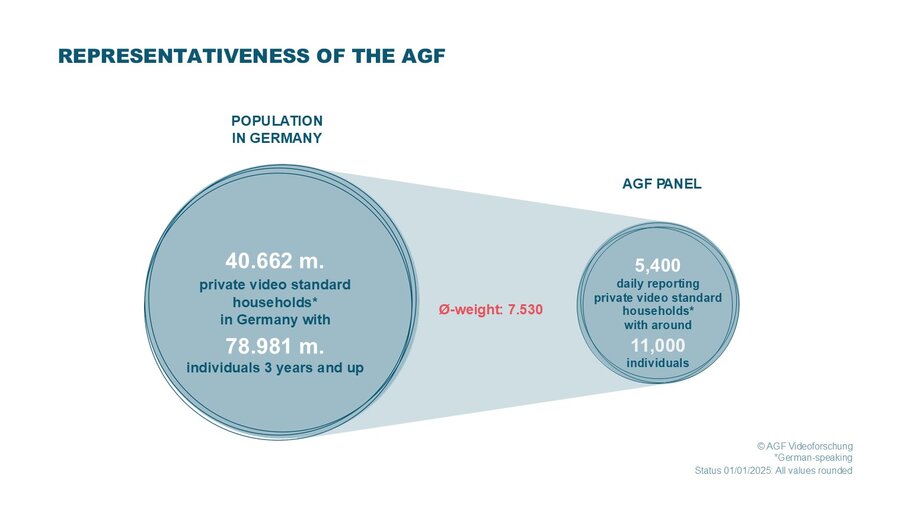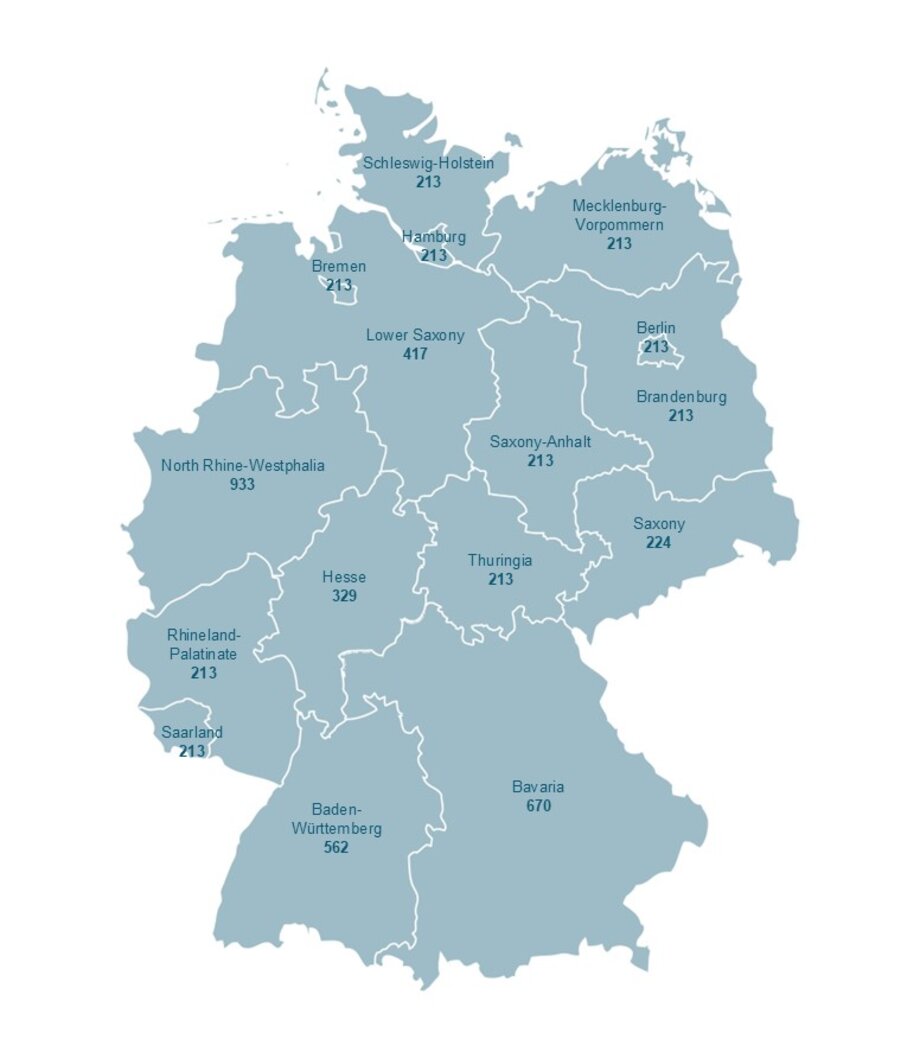TV
The cornerstone of audience research is the AGF Panel, which AGF operates in cooperation with GfK and has continuously developed from a TV panel into a video panel. AGF Videoforschung has systematically expanded the panel in multiple stages. While there were only around 2,700 TV households in the 1980s, the panel size has now almost doubled to at least 5,400 reporting households per day, with approximately 11,000 individuals.
In addition to TV households, the panel also includes so-called non-TV households—households without a traditional big screen but with streaming devices. The expanded panel serves as the foundation for evaluations within the video standard.

Universe
The expansion of the market standard TV to video in 2024 is accompanied by an extension of the target population. The target population now includes the residential population in the Federal Republic of Germany in private households with a German-speaking primary income earner and at least one TV device in use (TV households), as well as the residential population in the Federal Republic of Germany in private households with a German-speaking primary income earner, who do not have an operational TV device but have at least one streaming-capable device (Non-TV households).
With this target population, the video usage of approximately 78.981 million people aged 3 and above in 40.662 million video households is represented (as of 01/01/2025).
Panel Survey
The structural survey is an annual written survey aimed at updating the information about the panel households and all individuals living in them. It collects relevant structural and reception-specific household characteristics, as well as sociodemographic features and usage preferences of the panelists. The household and individual characteristics gathered form the basis for a wide range of target groups that can be analyzed. All new individuals joining the panel will also receive this questionnaire as part of the recruitment process. Topics covered include:
- Reception conditions in the household
- Equipment with technical devices
- Preferences for TV genres
- Device-specific internet and streaming usage
- Product usage
- Housing situation
- Sinus milieus
- Sociodemographic characteristics (e.g., age, education, gender)
External specifications
External guidelines are external requirements for the structural composition of the AGF panel. Since 01/01/2022, the AGF Video Potentials serves as the valid external guideline for the construction, control, and weighting of the AGF panel.
The AGF Video Potentials consists of two elements: the potential study, which the AGF has been conducting in cooperation with agma since 2020, as well as the AGF's own Platform Study.
Sample
The basis of the sample of panel households is the sampling system of the Arbeitskreis Deutscher Marktforschungsinstitute (ADM), which consists of approximately 53,000 sampling points. These are small areas made up of small communities, neighborhoods, or individual street sections, covering the entire inhabited area of the Federal Republic. This ensures that every household has a chance to be included in the sample for recruiting new households for the panel.
Recruitment (recruitment process)
The recruitment of households for the AGF panel is based on a representative sample using a random selection process (CATI or Random Route). In principle, it is also possible to achieve first contacts for specific target groups through quota-based recruitment. However, the share of such contacts must not exceed 30 percent of household recruitments per year.
After a brief screening, in which it is determined whether the household meets the target specifications for the AGF panel in terms of sociodemographic characteristics and reception situation, the detailed recruitment interview follows, where relevant characteristics of the household and its members are collected (analogous to the structural survey).
After successful recruitment, the measurement technology is installed, and the household is integrated into the daily reporting.
Weighting
The panel households are distributed across Germany, with at least 213 representative TV households available in each federal state. This ensures that there are sufficient households in even smaller federal states, enabling the inclusion of local TV providers.
The associated disproportionate distribution of households in the federal states is balanced out through daily weighting.
The non-TV households in the AGF panel are distributed across the four regions: North, South, East, and West, due to the lower number of cases.
The weighting process occurs in two steps:
- The preliminary weighting is performed daily, after GfK has transmitted and verified the data retrieved during the night.
- The final weighting is done eight days later, when the additional households retrieved during this period are incorporated, and the preliminary weighting factors are replaced by the final factors. Additionally, time-shifted usage from the past three days is taken into account.
The weighting process ensures precise extrapolation to all TV and video households and all individuals age 3 or over living in them throughout Germany.
Reception levels
The panel distinguishes four reception levels, which are considered as independent characteristics both in the recruitment process and in weighting:
- Until 2023: IPTV, Satellite, Cable, and Terrestrial
- From 2024: Satellite, Cable, Terrestrial, and Internet (TV)
Definitions of terms (from 2024):
- Satellite: TV reception via a satellite dish or a satellite communal system.
- Cable: TV reception via a cable connection, typically with a monthly fee paid to a cable network operator.
- Terrestrial: TV reception via DVB-T / DVB-T2, which requires a house, room, or rod antenna and a DVB-T / DVB-T2 receiver.
- Internet (TV): TV reception via the internet, including IPTV, OTT, and hybrid services.
The types of reception are determined in the households for all TV devices under measurement (including connected additional devices). Based on the hierarchy of reception levels, each household is assigned to exactly one reception level.
Development of TV reception levels (households in %)
| Date | Cable | Satellite | Terrestrial | IPTV | Internet (TV) |
|---|---|---|---|---|---|
| 01.01.2024 | 40.8 | 47.7 | 3.1 | 0 | 8.5 |
| 01.01.2023 | 43.6 | 43.5 | 2.9 | 10 | 0 |
| 01.01.2022 | 41.85 | 45.8 | 2.51 | 9.84 | 0 |
| 01.01.2021 | 41.4 | 45.4 | 2.1 | 11.1 | 0 |
| 01.01.2020 | 40.7 | 47.1 | 2.6 | 9.6 | 0 |
| 01.01.2019 | 39.7 | 45.6 | 2.6 | 12.1 | 0 |
| 01.01.2018 | 40.6 | 44.2 | 3.4 | 11.8 | 0 |
| 01.01.2017 | 41.7 | 46 | 3.3 | 9 | 0 |
| 01.01.2016 | 41.4 | 46.8 | 3.4 | 8.4 | 0 |
| 01.01.2015 | 43.5 | 46.1 | 3.5 | 6.9 | 0 |
| 01.01.2014 | 45.2 | 46.7 | 3.8 | 4.3 | 0 |
| 01.01.2013 | 45.5 | 46.5 | 3.7 | 4.3 | 0 |
| 01.08.2012 | 46.8 | 46.3 | 3.8 | 3.1 | 0 |
| 01.01.2012 | 48.6 | 47.4 | 4 | 0 | 0 |
| 01.01.2011 | 49.5 | 46.1 | 4.4 | 0 | 0 |
| 01.01.2010 | 50 | 45.3 | 4.7 | 0 | 0 |

